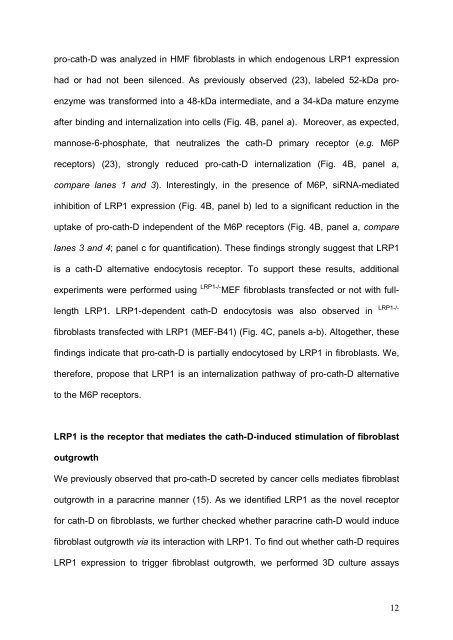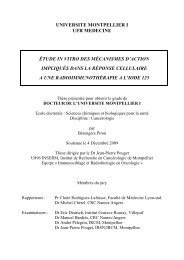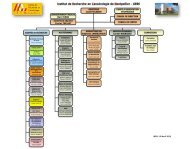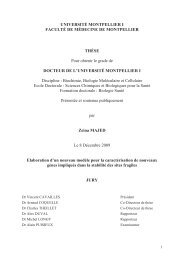Cancer du sein et micro-environnement tumoral: rôle de la protéase ...
Cancer du sein et micro-environnement tumoral: rôle de la protéase ...
Cancer du sein et micro-environnement tumoral: rôle de la protéase ...
You also want an ePaper? Increase the reach of your titles
YUMPU automatically turns print PDFs into web optimized ePapers that Google loves.
pro-cath-D was analyzed in HMF fibrob<strong>la</strong>sts in which endogenous LRP1 expressionhad or had not been silenced. As previously observed (23), <strong>la</strong>beled 52-kDa proenzymewas transformed into a 48-kDa intermediate, and a 34-kDa mature enzymeafter binding and internalization into cells (Fig. 4B, panel a). Moreover, as expected,mannose-6-phosphate, that neutralizes the cath-D primary receptor (e.g. M6Preceptors) (23), strongly re<strong>du</strong>ced pro-cath-D internalization (Fig. 4B, panel a,compare <strong>la</strong>nes 1 and 3). Interestingly, in the presence of M6P, siRNA-mediatedinhibition of LRP1 expression (Fig. 4B, panel b) led to a significant re<strong>du</strong>ction in theuptake of pro-cath-D in<strong>de</strong>pen<strong>de</strong>nt of the M6P receptors (Fig. 4B, panel a, compare<strong>la</strong>nes 3 and 4; panel c for quantification). These findings strongly suggest that LRP1is a cath-D alternative endocytosis receptor. To support these results, additionalexperiments were performed using LRP1-/- MEF fibrob<strong>la</strong>sts transfected or not with fulllengthLRP1. LRP1-<strong>de</strong>pen<strong>de</strong>nt cath-D endocytosis was also observed in LRP1-/-fibrob<strong>la</strong>sts transfected with LRP1 (MEF-B41) (Fig. 4C, panels a-b). Altog<strong>et</strong>her, thesefindings indicate that pro-cath-D is partially endocytosed by LRP1 in fibrob<strong>la</strong>sts. We,therefore, propose that LRP1 is an internalization pathway of pro-cath-D alternativ<strong>et</strong>o the M6P receptors.LRP1 is the receptor that mediates the cath-D-in<strong>du</strong>ced stimu<strong>la</strong>tion of fibrob<strong>la</strong>stoutgrowthWe previously observed that pro-cath-D secr<strong>et</strong>ed by cancer cells mediates fibrob<strong>la</strong>stoutgrowth in a paracrine manner (15). As we i<strong>de</strong>ntified LRP1 as the novel receptorfor cath-D on fibrob<strong>la</strong>sts, we further checked wh<strong>et</strong>her paracrine cath-D would in<strong>du</strong>cefibrob<strong>la</strong>st outgrowth via its interaction with LRP1. To find out wh<strong>et</strong>her cath-D requiresLRP1 expression to trigger fibrob<strong>la</strong>st outgrowth, we performed 3D culture assays12





